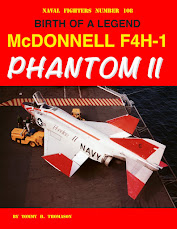That's not a problem, however, unless this is the only Vought drawing that you rely on.
To get details, you could simply visit one of the survivors that is on display, like the F7U-3M in the National Naval Aviation Museum at Pensacola, Florida. If you can't do that, then there are walk-around photo collections on the interweb, the best of which is Don Hinton's excellent set HERE.
Unfortunately, the NNAM Cutlass has detail shortcomings and differences in configuration that will lead one astray. For starters, it is not an F7U-3M unless F7U-3 outer wing panels have been substituted because it lacks the F7U-3M outboard pylons. (It is also marked with an F7U-3 Bureau Number but that might not be the airframe's in any event.)
(The extended lower inlet was in fact a retrofit on some F7U-3s.)
Another indication that it is an F7U-3 is that it was originally displayed with the inflight refueling probe, which was removed from the F7U-3M to make room for a radar dish antenna.
The major discrepancy is the external fuel tanks it is carrying are not correct for an F7U-3. See http://tailspintopics.blogspot.com/2017/08/relying-on-museum-examples-for-detail.html
The appearance of the nose gear scissors has varied over the years due to handling damage:
What's more, a unique feature of the F7U-3's nose landing gear has been removed. In order to reduce the kick-back load on the strut on touchdown, the nose wheels were spun up in flight by bleed air impinging on a turbine mounted on the inboard side of the wheel.
From Doug Reid:
The air came down a pipe on the back side of the strut. It had a telescoping section to accommodate the enormous change in strut length between weight on and off the wheels.
Bill Spidle provided a picture and drawing of the turbine (97 in the illustration above) that spun up the tire.
Also see: http://tailspintopics.blogspot.com/2015/09/f7u-3-nose-landing-gear.html
You can't ask for a better look at the NNAM F7U's cockpit unless you're seated in it. See HERE. Unfortunately, the cockpit is not accurate. One of the throttles is from an F8U Crusader, instruments and switches are missing, the gun sight is similar to the one in the earliest F7U-3s but probably not even correct for one of them, the ejection seat lacks detail, etc. Also see HERE.
While the airplane has an actual Vought F7U-3 ejection seat in it, the seat lacks detail like a cushion/survival pack, a parachute, shoulder harness, the ejection handle and curtain, etc. Also note that the Vought seat was also unconventional in that the seat bucket and head rest could be positioned separately for cruise, landing, air-to-air combat, etc. As a result, the headrests could be in slightly different positions.
I'm not sure about the afterburner. The museum's airplane has exposed afterburner petals.
Don Hinton Photo
In all the pictures I've seen of the F7U-3 afterburner, the petals are surrounded by a shroud that extends from the fuselage.
Another consideration is configuration. The NNAM F7U-3 has the engine inlet with the extended lower lip. This modification increased engine thrust at low speed. However, it was a retrofit to some F7U-3s and most if not all F7U-3Ms so it is not on the first F7U-3s that deployed.
(The vents aft of the gun ports were also a retrofit but most if not all F7U-3s that deployed went out with this mod or got it mid deployment.)
Thus endeth the lesson...











